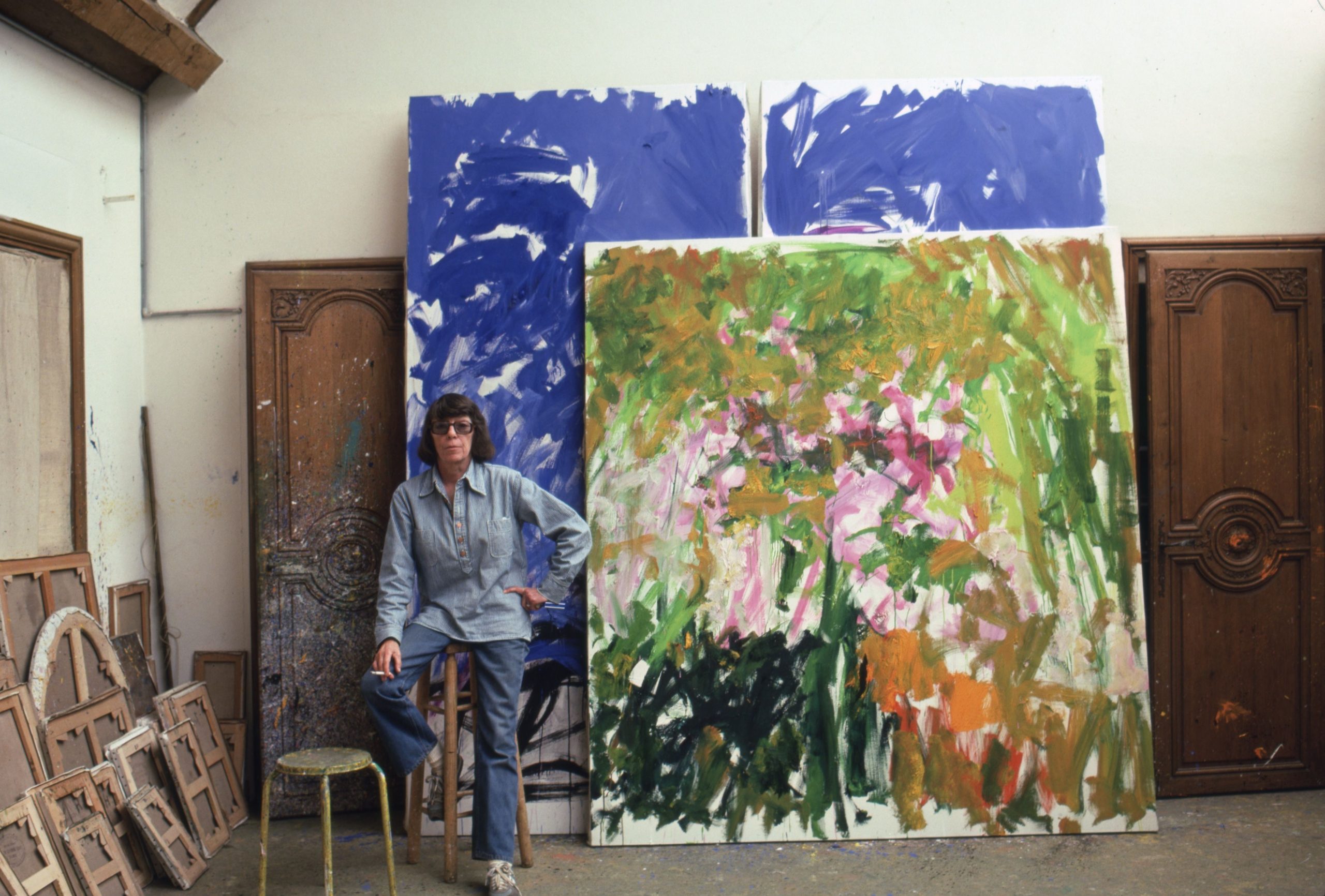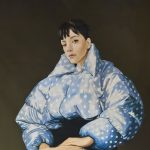
On the Practical Magic of Joan Mitchell’s Personal Style
In 1981, the late American Abstract Expressionist Joan Mitchell appeared in the pages of Vogue wearing a black leather blazer, cornflower blue turtleneck sweater, and a pair of rust-colored pants. Her trademark spectacles and no-nonsense Prince Valiant haircut, along with the electrifying diptych Two Sunflowers (1980), completed the scene. It’s a wonderful example of Mitchell’s often terrific style.
In the accompanying profile, art critic Barbara Rose remarked on the fact that Mitchell refused to remove her glasses, “even to be photographed”—adding that the “high degree of discipline in Mitchell’s work is especially surprising since she is so casual about dress and decor that she could easily be mistaken for the last Beatnik.”
This year marks the centennial of Mitchell’s birth (a new show, “To Define a Feeling: Joan Mitchell, 1960–1965,” opened at David Zwirner in New York this week), and it provides an opportunity to reevaluate the life and work of one of the greatest artists of the 20th century. In front of a Mitchell canvas, whether George Went Swimming at Barnes Hole, but It Got Too Cold (1957), La Vie en rose (1979), or the 21 paintings that make up the La Grande Vallée series (1983–84), all kinds of emotions can materialize. She channeled the thrill of color with her brushstrokes or marks—she used rags and her hands, too—often creating a kind of music for the eyes. At the Louis Vuitton Foundation in Paris, where a show that put her work in dialogue with Claude Monet’s ran simultaneously with a major Mitchell retrospective, I trembled at her paintings’ glorious rhythms and evocative mysteries.
Joan Mitchell, Mandres, circa 1962. Oil on canvas. 87 1/2 x 79 inches (222.3 x 200.7 cm). Private Collection.
© Estate of Joan Mitchell.
As Rose implied, Mitchell was not an obviously fashionable person. It seems highly plausible she felt the same way about clothes as she did about her work. “My paintings have nothing to do with what’s in and what’s out,” she told the New York Times in 1991, speaking from Vétheuil, France, where she had lived since 1968.
It’s a sentiment echoed by the gallerist John Cheim, who knew Mitchell in her later years. “Like her paintings, she is anti-style, very much an authentic rebel,” he says. “She wore what she liked—jeans, corduroys, turtlenecks, untucked Oxford shirts, suede athletic shoes, cashmere scarves—and she could wear this anywhere, anytime and look sharp and imposing.”
The first time he clocked her, it was in Manhattan, following a performance of Parade at the Met Opera in 1981. Cheim says Mitchell was wearing “a broad-shouldered, waist-length fur ‘monkey coat’ and slacks, with large, dark glasses. She struck me as a character out of a 1940s Hollywood film—perhaps Joan Crawford, Katharine Hepburn, or Barbara Stanwyck.”
Born in Chicago, Mitchell grew up in a rich family. Her father, James Mitchell, was a physician and president of the American Dermatological Association (he was also an amateur watercolorist), while her mother, Marion Strobel, was a co-editor of Poetry magazine, which published the likes of Ezra Pound. As a girl, Mitchell was a debutante, diver, and champion figure skater who loved dungarees and mannish shirts. She discovered Van Gogh at age six and wrote poems, one of which included the line: “Her eyebrows were plucked and she wore French heels.”
The quirks of Mitchell’s style could be partly explained by the starkly different circles that she moved within. “I think there was a divide that she was trying to navigate for many years between her family, who expected her to be a proper young lady, and her own rebellious streak and inner pull toward the artist community,” says Sarah Roberts, senior director of curatorial affairs at the Foundation. It was not unusual for Mitchell and her sister to change outfits several times a day: In a letter she wrote to her ex-lover Mike Goldberg at 28, when her father was in the hospital, Mitchell says: “I’ve been there three times to see him – keep changing clothes to please him…” At the same time, her penchant for trench coats, tailored pants, simple knits, and loafers with socks in 1950s New York—an aesthetic she maintained in Paris into the ’60s—made a kind of statement at a time when womenswear was dominated by perky dresses, hats, and nylons.
“When I was getting to know Joan, I think she had decided she didn’t have to impress anybody with what she put on. But that doesn’t mean she wasn’t particular or didn’t care,” says Jill Weinberg Adams, whose relationship with Mitchell began when Adams was working for gallerist Xavier Fourcade in the late ’70s. “We know she was raised in an upper-crust family. I am sure that she was experienced, as well as trained, in how to present herself in social and professional settings.”
“She was the Wasp who conquered France and had great love affairs!” drawls artist Billy Sullivan, who met Mitchell when she was showing at the Robert Miller gallery in the late 1980s. “I just thought that was how someone from Chicago would dress, with international style. She wasn’t going to go with the latest look. She had her look.”
Sullivan adds that Mitchell had “a lot of swagger—the way she held a cigarette, the way she moved.” Did they ever shop together? “Never for clothes. Oh, she wouldn’t do that.”
“Regarding Joan and fashion, I’m sure she did not really follow it,” remarks Guy Bloch-Champfort, a lawyer and the author of Joan Mitchell: By Her Friends. But she did notice it. When Bloch-Champfort brought his mother to see Mitchell in the hospital, she later recalled that “Guy came to visit with his mother and she was all in Chanel.” An eight-page letter in the Foundation’s archive, from Mitchell to her ex-husband Barney Rosset in 1979, also notably mentions a rather modern, high-low combination of Yves Saint Laurent trousers and Adidas sneakers. It reads: “Found ‘solution’ to my back through Karen Edwards – “Adidas” – sneakers – have joggers, red for Paris – Trackers blue for painting & will get yellow & whatever & wear only those even to White house if necessary with velvet pants St. Laurents.”
Letter from Joan Mitchell to Barney Rosset (page 4 of 8), August 26, 1979. Joan Mitchell Foundation Archives, New York.
© Estate of Joan Mitchell
“Everything about her was no-nonsense and practical, even her boxy haircut with its straight curtain of bangs,” says the artist Peter Soriano, who considered Mitchell a mentor. “She couldn’t stand people who fussed with themselves. One critic we both knew kept brushing his hair out of his face, and it drove Joan nuts.”
Adams and Bloch-Champfort remember Mitchell’s suitcase, which was usually stored on the billiard table at Vétheuil. “It was the suitcase to go on the road, to come to New York, to visit her sister in California, and even though it would often be on the billiard table open, I don’t think it was something that she unpacked and repacked for the next trip,” says Adams. “I think it had whatever her current selection was of the clothes that she was going to wear when she was not at home in the studio.”
Bloch-Champfort, who worked for Dior and Celine during his friendship with Mitchell, remembers a green-blue wool cardigan of his that she wore to the 1982 opening of “Joan Mitchell: Choix de Peintures, 1970–1982” at the Musée d’Art Moderne de Paris. If it was a decidedly more casual look than, say, the unstructured sapphire-blue velvet blazer, blue turtleneck, and mauve flared pants that she wore to an opening at the Whitney in 1974, it was equally specific, bold—and a long way from her bourgeois roots.
It also fit a pattern: Several of the pieces in which Mitchell was photographed the most were gifts from friends. She often wore a golden yellow parka from Bloch-Champfort in the garden at Vétheuil, and treasured a Willem de Kooning T-shirt given to her by her dealer and gallerist Xavier Fourcade. But one of the best examples is surely a sweatshirt, featuring four white bears with red ribbons looped around their necks, that Adams remembers artist Matthew Morley giving to Mitchell. She wears it in the documentary Joan Mitchell: Portrait of an Abstract Painter by Marion Cajori.
Mitchell’s sparky sartorial style, which significantly predated the art world’s wider involvement with fashion, is ultimately due celebration because it’s so full of genuine, unabashed character. There is a scene in Cajori’s hugely watchable film that sees Mitchell sitting at a table with a vase of yellow flowers on it, presumably from her garden. There is nothing particularly exceptional about her look—she is wearing a blue cardigan, slim cords, and black leather slippers—and yet everything about it seems perfect; absolutely, brilliantly Joan. That, in the end, was her great style secret: as Adams puts it, Mitchell merely “set aside conventional expectations and independently dressed for herself.”
“To Define a Feeling: Joan Mitchell, 1960–1965” is at David Zwirner at 537 West 20th Street, New York, December 13, 2025.












Warning